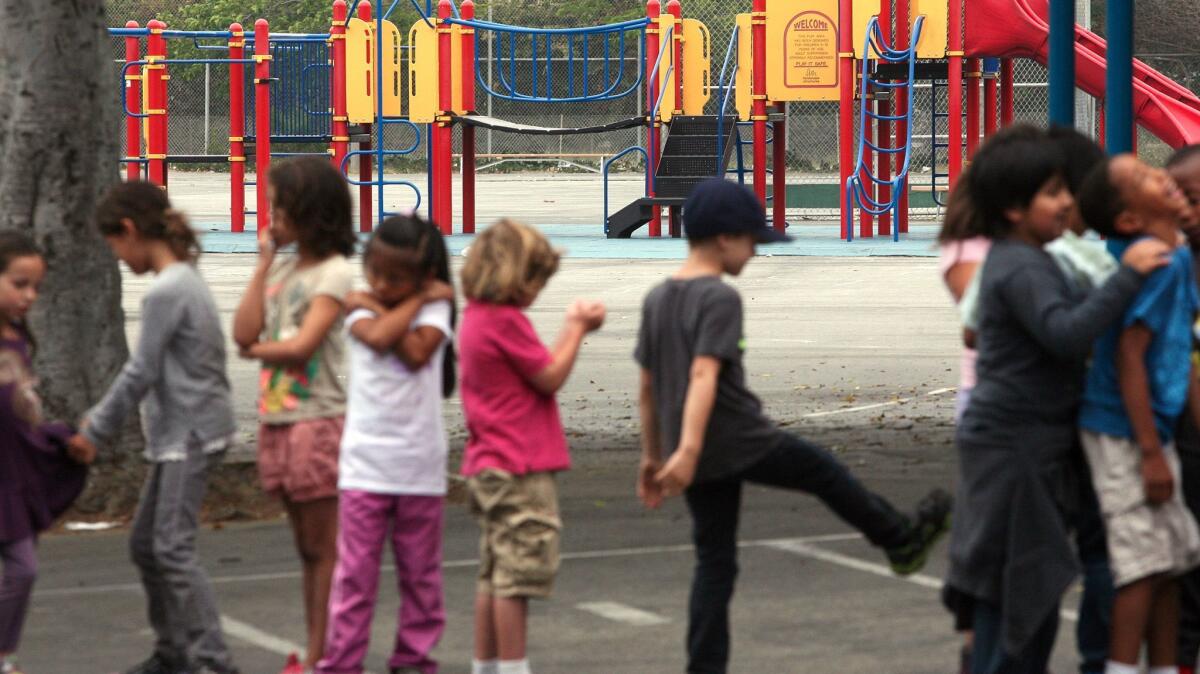East Coast experts criticize California’s plan to satisfy a federal education law

California’s proposed plan to satisfy a major federal education law is falling short, according to a new report.
While the report by the Boston-based nonprofit Bellwether Education Partners praises the state’s Every Student Succeeds Act plan for using multiple signs of student performance and employing up-to-date tests, it highlights the plan’s lack of detail about how it will identify and help low-performing schools.
“The current method of measuring growth does not actually capture individual students’ improvement over time,” the report states.
President Obama signed the Every Student Succeeds Act (ESSA) in 2015 to replace the No Child Left Behind Act. Where the much-criticized former act took a prescriptive, test-score-based approach to grading schools, ESSA gives states more agency to design their own systems.
California’s State Board of Education spent months soliciting feedback and fine-tuning its plan. Gov. Jerry Brown must now review the plan before a Sept. 18 submission deadline.
Four education experts looked at the state’s plan for Bellwether, which aims to help educational organizations become more effective. The report was written in partnership with the Collaborative for Student Success, a Virginia nonprofit that promotes high academic standards. Here are two problems they found:
1) Inadequate identification of underperforming schools
The law requires states to use academics and other factors to assess schools, and says that states must identify its bottom 5% of schools serving low-income students and intervene to improve them. It is largely up to states to determine which schools are in that bottom tier.
But according to the report, California’s plan doesn’t clearly state how it will do that.
California plans to use ratings on the School Dashboard — a color-coded school grading tool — to identify its lowest-performing schools: On the Dashboard, red is the color denoting lowest performance. Orange is the next lowest color. In California’s plan, those deemed either red across all measures or all red with one orange category will be flagged. But by that criteria, the state will be able to identify only one-third of the schools that would make up the lowest 5%.
The State Board of Education this summer deferred until January a final decision on how to identify the rest of the bottom 5%.
The Bellwether report said it’s hard to know how the different factors schools are graded on — such as academics and suspension rates — will come together to differentiate good and bad schools. The report also said that the Dashboard could hide some schools’ underperformance. A school, for example, could fall outside the bottom category if it had poor ratings for its academics and graduation rate but better ones for such factors as suspension rate.
2) Lack of specifics on required intervention
The report dings the state plan for not specifying how districts and the state would intervene to improve underperforming schools.
“The state’s plan would be greatly improved by including more details about its system of supports and interventions, including the timing of any interventions, the funding allocated to low-performing schools, and any actions the state takes if district-level improvement efforts prove ineffective,” the report states.
Bellwether also criticizes the state plan for being unclear about what a school has to do to no longer be considered underperforming. “As currently proposed, schools could potentially exit improvement status without making any improvements,” the report states. “Rather than having a clear target, schools will be left to guess about what level of performance will be good enough in future years.”
David Sapp, deputy policy director and assistant legal counsel for the California education board, questioned the report’s conclusions. Sapp said the report wrongly suggests that because something isn’t mentioned in the state’s ESSA plan, the state isn’t doing it.
“It isn’t an accurate or fair portrayal of what California is doing,” he said.
The report, for example, criticizes California for not using a system that tracks individual students’ progress, Sapp said. But he said the state Board of Education has indicated that it intends to create such a system by next fall, in time for the first year that California plans to identify low-performing schools under ESSA.
Also, the state has its own school accountability system, the Local Control Funding Formula, with categories for identifying underperforming schools, he said. “We’re not going to include a whole bunch of stuff outside the scope of what the federal government is asking for.”
California State Board of Education president Mike Kirst responded later Thursday with a detailed critique of the report. Among other issues he had with the report, he said that the Dashboard itself is clear enough and that the student-level growth metric is not required by the law itself.
To read the article in Spanish, click here
UPDATES:
4:15 p.m.: This article was updated to include a response from Mike Kirst.
This article was originally published at 1:50 p.m.
More to Read
Sign up for Essential California
The most important California stories and recommendations in your inbox every morning.
You may occasionally receive promotional content from the Los Angeles Times.











